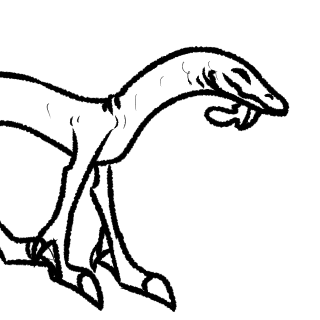[Cosmosdex] The Universal Encyclopedia
[Cosmosdex]
Squarmid
Plated River Serpents / Thievingdragons
Squarmid

No art currently, maybe you can help
- Strength-4
- Intelligence-2
- Charisma-1
- Endurance-3
- Agility-6
- Luck-0
Danger Level: Low
Likes: New things, Shiny items, Puzzles, Water, Other squarmids
Dislikes: Extreme cold, Isolation, Large open areas
Attack Method: Either bites, kicks with its spurs, or hits the opponent with its long tail.
Attributes
Environment: Forests, Lakes, Near rivers, Near oceansLifespan: 60 years
Size: 4.5 ft tall, 7.8 ft long
Diet: Meat, Fish
Bodytype: Quadruped
Type: Reptile
Rarity: Uncommon
Original Creator: Chipper
Physical Description
A squarmid (skwaw-mid) is a mostly-scaleless quadruped reptile used as a capture creature, with a long neck and a longer tail. The typical squarmid has four dog-like limbs, each ending in one large toe, with what could be described as dewclaws, connected to the main 'foot' by webbing. In the hind feet, these dewclaws are longer, and face to the back, serving as spurs. There is also more webbing on the hind feet. Most squarmids are decent runners, and not too bad at swimming.
A squarmid's head is slightly flat, with a long snout, and two nostrils facing upwards. They also have two openings for gills, on their cheeks, protected by durable scales. Although for the most part a squarmid is naked, they do have scales in many places, with three main 'types'. Small, rounded, immovable scales, typically covering their more vulnerable areas, such as the throat, legs, and going down their sides, all the way to their tail. Sharper, longer movable scales, forming a crest, a ruff, and, most notably, on the end of their tail. The hook-like scales on the end of their tail are also counted under this type. The third and final type of scales would be the larger, rounder plate-like scales, which are also movable. These cover many parts of the tip of the tail, hiding the other, smaller scales from sight. The tail-tip scales are one of the most notable parts of a squarmid.
This is because of the function they serve - all the tail-tip scales form what, when revealed, seems to be a mess of hooks, spikes, and just simple scales. These can be used to hold, and thus hide, many different types of items, with varying success. Food, shiny objects, sticks, 'interesting' leaves, and clusters of fur or feathers are some of the typical types of items that a squarmid will hide in its tail, covered by the plate-like scales. Unless it was hatched without these plate-like scales, although they are physically safe to remove if done correctly, a squarmid will grow anxious if it cannot hide items, refusing to pick up anything. Due to the way they insist on storing food for later, a plateless squarmid will likely end up refusing to eat, and thus dying.
Squarmids usually have dull-coloured skin and scales, with the scales usually being darker or lighter than the skin (but the same hue). All types of scales are the same colour, except for in rare cases. They tend towards greens, teals, or oranges, though squarmids that are other colours aren't unheard of. Greys are far rarer. Patterns are somewhat common, usually being stripes, patches, or spots, along with 'sock' patterns. A squarmid has warm-coloured eyes, with darker, rounded pupils, and one barbel on its chin, usually referred to as a 'wattle' due to its visual similarity to true wattles. Although naturally this wattle would have a larger, more pronounced frill connected to it in males and a far smaller frill in females, squarmids used as capture creatures tend to only have a small frill regardless of whether they're male or female.
Behavior
A squarmid is a capture creature with a simple 'lesson', given mainly to J-class children. Anyone who has watched a squarmid can summarise its behaviour with a simple phrase - squarmids are thieves. Being extremely curious, squarmids tend to pick up whatever they find interesting, or whatever their owner seems to be interested in keeping, and store it in their tail scales. Due to this, it is common for a squarmid to steal something from its owner that was important to the owner. In fact, this is part of the point.
Squarmids, while not incredibly intelligent due to still being just fauna, seem to be almost purposefully difficult in behaviour. If a squarmid steals something, the J-class owner will have to guess under which plate scales the squarmid is keeping the item, based on the cue the squarmid gives. What this cue is can depend on the squarmid, and in some cases if two or more squarmids in the area for enough time they may learn cues from each other, meaning that there is no one set way to tell what the squarmid has hidden and where. In some cases, a squarmid may also give off a slightly different cue, as if hiding something, only for it to turn out to have taken nothing at all. The J-class owner will have to learn the difference between different cues, and be certain of when their creature is lying. This behaviour does not grow lesser as the squarmid becomes closer to its owner - some of the time, the squarmid's cues will become more similar, or even change cues entirely. A notail with a squarmid will usually become more observant, learning what small changes in somebody mean more quickly.
A squarmid usually uses certain parts of its tail for certain types of items, such as using one section of scales for keeping food and another for keeping small, shiny objects. Similarly to the cues, which section is used can depend on the squarmid. What a squarmid steals can range from trinkets to things that are vital for the notail's survival - most squarmids will treat both extremes similarly. Another curious behaviour of squarmids is the way they eat. A squarmid will store any food it's given within its tail scales for later, refusing to eat it straight away. It will hide food as carefully as any stolen item, and usually refuse to store or take the food out later unless it highly trusts whoever else is nearby. In non-capture creature squarmids, this urge is lessened.
Another notable part of a squarmid's behaviour is how social they are - although a squarmid will fight in a capture creature fight as well as any other creature, naturally squarmids will travel in flocks. It takes very little for a squarmid to consider a notail (and the notail's other capture creatures) as part of its 'flock', and it is rare for squarmids to attack those from other flocks unless encouraged to. However, a squarmid will fiercely protect those in its flock if threatened. When two squarmids meet, they commonly swap items from their tail. There is very little link between the value of items between being swapped - the same two squarmids could exchange many of one item for another item in one meeting, and only one of one item for another item in another meeting. Sometimes, two squarmids won't swap items. Instead, one will give another an item, getting nothing in return. This gift is usually food.
Although mainly made for the J-class, squarmids, in particular duds without plate scales, can also be given to K-classes, E-classes, G-classes, or X-classes.
Subspecies
Wild: Wild squarmids, at a glance, are quite different from a 'normal' squarmid. They are larger, longer, have longer and sharper scales, and, most noticeably, are aquatic. Instead of having one toe touching the ground and one dewclaw on each foot, wild squarmids have two long digits on each foot, connected by webbing to form fins. Wild squarmids are actually about as social as capture creature squarmids, though most assume that they are more dangerous, based on their appearance.
Terrestrial: More commonly known as domesticated squarmids. They appear similar to the version used as capture creatures, though with brighter colours. 'Capture creature squarmids' originate from this type, but are more common.
Special
Hiding Something: Squarmids are usually very good at hiding items beneath the scales and hooks on their tails. Whether it's their food or a stolen trinket, the only sign is usually the cues a squarmid gives.
Trivia
• A squarmid's cue can be of many different types, such as chirping, making hissing sounds, rustling their ruff and crest in a certain way, tapping with their claws on the ground, or others. However, most squarmids will only use one basic type of cue.
• Squarmids tend to appear as if they are smiling, though this in no way reflects their emotional state, and is just the way their mouth and eyes rest.
• Squarmids tend to range from only rarely making noises to being extremely noisy. Some of the noises they can make include chirps, hisses, chitters, squeaks, and a noise commonly described as a sort of mew.

